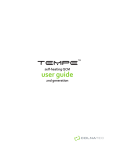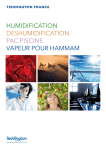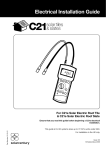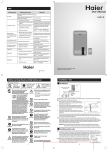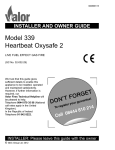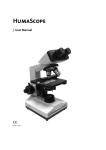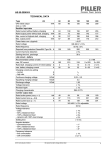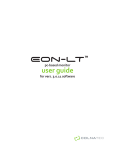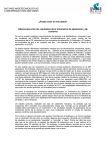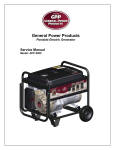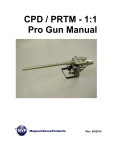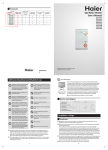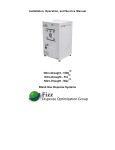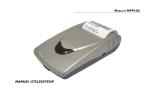Download Phoenix™ Manual Gen.2
Transcript
phoenix temperature monitoring QCM user guide 2nd generation TM Contents 4 5 5 Chapter 1: Phoenix™ Sensor at a Glance 6 6 Chapter 2: Eon-LT™ System Components Phoenix™ Subcomponents Phoenix™ Base Subcomponents Eon-LT™ and Accessories 10 10 12 12 Chapter 3: Eon-LT™ Inputs & Outputs 13 13 16 17 Chapter 4: Hardware Connections 19 19 20 Chapter 5: Electronics Connections 22 22 Chapter 6: Troubleshooting 23 23 24 Chapter 7: Specifications Eon-LT™ Connectors Eon-LT™ Inputs Eon-LT™ Outputs Preparing Phoenix™ for Chamber Chamber Installation Connecting to Phoenix™ Connecting Phoenix™ and Eon-LT™ Connecting Eon-LT™ to PC Troubleshooting Hardware Electronics Contents 2 Contents 25 25 Appendix A: Phoenix-Eon-LT™ System 26 27 27 27 Appendix B: Safety, Handling, & Support 29 Appendix C: Tooling Factor 30 Appendix D: Phoenix™ Dimensions 31 Index Contents Phoenix-Eon-LT™ System Configuration About Phoenix™ Inspection & Initial Setup Warranty 3 Phoenix™ at a Glance 1 This guide discusses assembly and proper care and handling of Phoenix™ (2nd generation) sensor with temperature control. inspect product condition on arrival Examine Phoenix™ for any signs of physical damage that may have occured during shipping. Make sure that the tamper-evident labels are intact. Before shipping, Phoenix™ was calibrated and tested by Colnatec to meet the highest quality standards. It is important that you take a few minutes to inspect the product to ensure that your equipment was not damaged or otherwise tampered with during transit. Chapter 1 Phoenix™ at a Glance 4 Phoenix™ Subcomponents The sensor head features many sub-components. The usage of these components will be detailed in later sections. 1 2 4 5 5 3 3. Flange Acts as nearly airtight barrier sealing sensor head in chamber 1. Sensor Head Houses quartz crystal 2. Crystal Control Cables Transmits control and monitoring data between sensor head and controller 4. Thermocouple Connector Measures temperature around sensor head 5. Cooling Tubes For cooling sensor head Phoenix™ Base Subcomponents The sensor head features many base sub-components. The usage of these components will be detailed in later sections. 1. SMA Coaxial Connection For crystal frequency measurement 2. Cooling Tubes For cooling the sensor head 3. Thermocouple Measures temperature around sensor head 1 2 2 Chapter 1 Phoenix™ at a Glance 3 5 Eon-LT™ System Components 2 Eon-LT™ and Accessories Phoenix-Eon-LT™ ships with a variety of accessories. Eon-LT™. A temperature measuring film thickness monitor that surpasses conventional monitors that are blind to thermal changes of the crystal. The combination of frequency and temperature measurement allows unprecedented accuracy in real-time rate and film thickness monitoring. While Eon-LT™ Monitor is compatible with industry standard crystal sensors, it was also specifically created to be paired with Colnatec’s Phoenix™ in combination with AT or RC™ 6 MHz crystals to accomplish a degree of precision never before imagined in the world of thin film. Chapter 2 Eon-LT™ System Components 6 inspect product condition on arrival Examine Eon-LT™ for any signs of physical damage that may have occured during shipping. Make sure that the tamper-evident labels are intact. Before shipping, Eon-LT™ was calibrated and tested by Colnatec to meet the highest quality standards. It is important that you take a few minutes to inspect the product to ensure that your equipment was not damaged or otherwise tampered with during transit. warranty label If the warranty label has been tampered with, “VOID” will appear where the warranty label was originally placed. If this is visible at the time of arrival, it is important that you contact Colnatec immediately after receiving the product. Chapter 2 Eon-LT™ System Components 7 Power supply and cable. Input 100-200 VAC, 50/60Hz, 2 A. Output 24V, 3.75 A, 90W Max. RS-232 extension cable. Male-to-female serial cable. USB to RS-232 adapter. Connects RS-232 cable and PC. Chapter 2 Eon-LT™ System Components 8 External oscillator. Replaces the Eon-LT™ internal oscillator. Phoenix-Eon-LT™ quick reference guide. Instructs user in quickly assembling and integrating Eon-LT™ into existing system. Software CD. Contains Eon™ software suite, manuals, quick reference guides, and other helpful resources. Chapter 2 Eon-LT™ System Components 9 3 Eon-LT™ Inputs & Outputs This guide describes Eon-LT™ controller with temperature control (3rd generation). Eon-LT™ Connectors Eon-LT™ Front Heater and RTD Input/Output Controls Phoenix™ sensor head. BNC Sensor Inputs Connects to sensor head via external oscillator. Type K Thermocouple Inputs Measures temperature using thermocouples. 0-5 VDC & Relay Output Connects the 0-5 VDC output for the deposition source, the 24 VDC Mirage™, and the relay control. Eon-LT™ Back Power Input Connects to 24 VDC power input RS-232 Connects Eon-LT™ to PC. (Always use the provided USB-to-RS232 cable). LED Indicator Displays status Chapter 3 Eon-LT™ Inputs & Outputs 10 Warning Make sure the correct hardware is used with Eon-LT™ inputs and outputs. See proper setup procedures in this manual and in the Phoenix-Eon-LT™ quick reference guide. Warning Only the provided power supply should be used with Eon-LT™. Using an alternative power supply may damage product and void warranty. Chapter 3 Eon-LT™ Inputs & Outputs 11 Eon-LT™ Inputs The Eon-LT™ utilizes four (4) inputs. Make sure the correct hardware is used with these inputs. Power Only the provided power supply should be used with Eon-LT™. Not doing so will cause hardware damage to Eon-LT™ that will not be covered by warranty. Ensure that the power supply has a 24 VDC. ComPort Connect an RS232 cable to this port. Always use the provided USB to RS232 cable. BNC Sensor Inputs Eon-LT™ has a built in oscillator. (Colnatec also offers an external oscillator for purchase). The cable between Eon-LT™ and the crystal should remain as short as possible to avoid noise. The advisable maximum acceptable length for this is one (1) foot or 30 cm. TC Connection Eon-LT™ uses a thermocouple probe to measure the temperature of the sensor head. Eon-LT™ Outputs The Eon-LT™ utilizes one (1) output. Make sure the correct hardware is used with this output. DB9 Connector Connects the two SPST relays and two source outputs. Chapter 3 Eon-LT™ Inputs & Outputs 12 Hardware Connections 4 Preparing Phoenix™ for Chamber Removing Mock Crystal 1. Turn cap COUNTER CLOCKWISE to loosen and remove. 2. Flip cap over to access crystal retainer ring. Turn retainer ring COUNTER CLOCKWISE until loose. 3. Remove retainer ring to access mock crystal. Chapter 4 Hardware & Connections 13 4. Remove mock crystal from sensor head cap. Adding New Crystal 1. Rotate crystal carousel until the round opening appears above an available crystal. 2. Place rear of sensor head against the opening. 3. Flip crystal carousel and allow crystal to drop into sensor cap housing. Chapter 4 Hardware & Connections 14 4. Use a plastic prod to adjust crystal position until crystal rests snugly in the crystal seat. 5. Place the threaded side of the retainer ring onto the corresponding threads of the sensorcap. Tighten the retainter ring by turning the ring CLOCKWISE. 6. Place cap onto corresponding threads of crystal compartment. Turn CLOCKWISE until secure. Chapter 4 Hardware & Connections 15 Chamber Installation 1. Remove copper gasket from packaging and thread onto sensor head. 2. Fit gasket into circular groove on Conflat. 3. Hold copper gasket in place while inserting sensor head into chamber feedthrough. 4. Press sensor head and feedthrough flanges together. Align bolt holes. Apply bolts and plate-nuts. Tightening bolts compresses copper gasket between a sharp edge and a tapered groove, thus creating a strong seal. Chapter 4 Hardware & Connections 16 5. Apply bolts and plate-nuts. Tightening bolts compresses copper gasket between a sharp edge and a tapered groove, thus creating a near-perfect seal. 6. Access to Base Connections Once the bolt ring has been tightened into place, user will have open access to all of the base connections on the Phoenix™. (See Page 5 for a complete list of all base connections and their purpose). Warning Hand-tighten flange bolts before using wrench, alternating among bolts and using a sequential torque pattern. Over-tightening flange bolts may cause microfractures to develop in copper gasket. Seal may become weakened, resulting in chamber leakage. Connecting to Phoenix™ 1. BNC Coaxial Cable to Position Phoenix™ Spin cable in place using cable shaft until resistance is felt. (Twisting cable shaft past point of resistance may damage cable). Roll fingertip over connector to tighten. Chapter 4 Hardware & Connections 17 2. Connect Phoenix™ to Eon-LT™ Connect BNC extension cable to SMA, which then connects to the BNC adapter cable using the provided BNC union. Then, connect the other end of the BNC extension cable to the Eon-LT™ coaxial input (either sensor 1 or 2). 3. Connect Phoenix™ TC Connector to TC Extension Cable Connect Phoenix™ TC cable to TC extension cable. Wide blade (-) fits into wide slot on female thermocouple socket. Narrow blade (+) fits into narrow socket. 4. Male TC Adapter to Eon-LT™ TC Female Socket Plug thermocouple extension cable connector into the Eon-LT™ TC socket with the wide blade (-) corresponding to the upper slot and narrow blade (+) fitting into lower slot. Warning Length between the Phoenix™ crystal compartment and the Eon-LT™ should NOT exceed 30 inches (76 cm) to avoid erratic noise levels in oscillation reading. Chapter 4 Hardware & Connections 18 Electronics Connections 5 Connecting Phoenix™ to Eon-LT™ 1. BNC Coaxial Cable to Eon-LT™ Slide coaxial connector onto BNC Sensor Input 2. 30” Warning The cable between Eon-LT™ and the crystal should remain as short as possible to avoid noise. If using the internal oscillator alone the advisable maximum acceptable length for the cable is one (1) foot (30 cm). Warning DO NOT allow operating temperature to exceed 500°C. Equipment damage will likely result. Chapter 5 Electronics Connections 19 Connecting Eon-LT™ to PC 1. Install Eon-LT™ Software onto PC Insert the accompanying Eon-LT™ software CD into disc drive. Follow prompts to install software onto PC. 2. RS-232 to Eon-LT™ Plug RS-232 connector into female serial port on rear panel. Tighten integrated screws. 3. RS-232 cable to USB Adapter Plug the other end of the RS-232 cable into the USB-to-RS-232 adapter. Tighten integrated screws. 4. Plug USB-to-RS-232 Adapter into PC Plug USB-end of the USB-toRS-232 adapter into PC. Chapter 5 Electronics Connections 20 5. Connect Power to Eon-LT™ Plug Eon-LT™ power adapter into AC outlet. Then plug DC connector into the Eon-LT™. 6. Start Eon-LT™ Software Start Eon-LT™ software and follow the First Start setup procedure described in the Eon-LT™ User Manual (available on the Eon-LT™ software CD). Warning If drivers are already installed, simply update the drivers when installing software. Use only the provided USB cable. Ensure that the software has been fully installed before connecting the USB drivers. Fully reboot the computer after the software installation to prevent drivers issues. Chapter 5 Electronics Connections 21 6 Troubleshooting Symptom Cause Solution Broken Crystals Crystal not seated properly. Make sure that the crystal is seated properly in the cap and retainer to avoid mechanical stress on the crystal when temperature rise. Weak Crystal Reading Contact spring may have become bent. If the crystal contact spring has become bent, it may no longer apply even pressure against the crystal. Assuring the conical spring is concentric with the body may resolve this issue. Software Issues Various possible causes. See Eon-LT™ Controller manual for software troubleshooting guide. Because it is a scientific instrument, the Phoenix™ sensor head should be treated with care. In the event of any difficulties please contact Colnatec’s Customer Support. Excessive tinkering or fiddling may result in greater damage to the unit. If you cannot resolve an issue, please contact [email protected], or call (480) 634-1449. Warning Do not attempt to repair electrical problems. Tampering with the Phoenix™ electrical systems may result in electrical fire, increased interference in crystal measurement, and damaged ceramic insulators. Chapter 6 Troubleshooting 22 7 Specifications Hardware Flange Size KF40, KF-50, CF275 Head Orientation 180° Concentric Flange to Crystal (designed to specification) Cooling Tube 3/16 Diameter Component Materials Sensor Body 304 SS nickel alloy contact springs, 304 SS screws Type K Thermocouple 304 SS Sheath, .125” Crystal Cable Stainless steel-covered high-temp wire; nickel plated copper wire conductor Crystal Cable Stainless steel-covered high-temp wire; nickel plated copper wire conductor Dimensions Length 4” to 24” depending on customer requirements Cross Section Able to be passed through a 2.75” ConFlat port Operating Temperature 40-500º C Vacuum Rating 1x10-5 Torr Material AIS304 SS Part Number CNT-TMP-2000 Rev. 3.1 (B) Chapter 7 Specifications 23 Electronics Temperature Range 0-500°C Crystal Standard 14 [mm] Frequency Measurement Connection SMA Coaxial Chapter 7 Specifications 24 A Appendix Phoenix-Eon-LT™ System Phoenix-Eon-LT™ System Configuration Rendering illustrates basic connections of Phoenix-^IEon-LT™ system. Eon™ software installed on your PC Eon-LT™ Monitor TC cable Remote oscillator QCM substrate source shutter Appendix A Phoenix-^IEon-LT™ System 25 B Appendix Safety, Handling, & Support Warning All electrical components are to be considered extremely dangerous if tampered with in any way. Colnatec is not liable for any injury resulting from product misuse, modification, or disassembly. Warranty Label If the warranty label has been tampered with, “VOID” will appear where the warranty label was originally placed. If this is visible at the time of arrival, it is important that you contact Colnatec immediately after receiving the product. Appendix B Safety, Handling, & Support 26 Eon-LT™ Examine Your new phoenix™ for any signs of physical damage. Before shipping, your Phoenix™ was calibrated and tested by Colnatec to meet the highest quality standards. It is important that you take a few minutes to inspect the product to ensure that your equipment was not damaged or otherwise tampered with during transit. About Phoenix™ Temperature fluctuation is the most significant cause of frequency drift in crystals. Traditional sensor heads address this with water-cooling. While many manufacturers advise that crystal temperature be kept “around 20°C”, their sensors have no means of measuring temperature. Real-world application has shown that a standard water-cooled sensor can experience a 20°C discrepancy within as little as 10 minutes during highrate deposition. In an industry of nanometer measurements, this level of variance will easily result in significant inaccuracy within thickness reading. The Phoenix™ was designed to address this flaw, by employing an embedded thermocouple that may be read with a simple thermocouple meter. When integrated with the Eon-LT™ film thickness monitor or controller, both temperature and frequency are automatically graphed alongside the corresponding rate and thickness values on a personal computer, allowing for real-time correction and accuracy up to .001 Hz. Inspection and Initial Setup Examine Phoenix™ for any signs of physical damage. Also, make sure that the tamper-evident labels are intact. In order to ensure safe, correct operation of your Phoenix™, please follow the step-by-step instructions presented in the Phoenix™ Quick Start guide included with your product. Warranty Phoenix™ is warranted to the original purchaser to be free of any manufacturing-related defects for one year from the date of purchase. Colnatec reserves the right to repair or replace the unit after inspection. Appendix B Safety, Handling, & Support 27 Contact Colnatec Support 511 W. Guadalupe Road, Suite 23 Gilbert, AZ 85233 (480) 634-1449 [email protected] www.colnatec.com Appendix B Safety, Handling, & Support 28 Appendix C Tooling Factor Cr ys t al Source Appendix C Tooling Factor 29 Appendix D Phoenix™ Dimensions 29.845mm 1.18in 12.319mm 0.49in 31.623mm 1.25in Flange: 1. CF275 2. CF338 3. KF40 4. KF50 Flange to Crystal Distance (FCD): 6"-24" 2.077mm 0.08in 7.912mm 0.31in 11.240mm 0.44in 4.991mm 0.20in Tube Diameter 1: 3/16 11.240mm 0.44in Parallel Perpendicular Orientation: 1: Perpendicular 2: Parallel Appendix D Tooling Factor 30 Index B BNC Coaxial Cable 17, 19, 31 C Chamber Installation 16, 31 Compressed Air 31 ConFlat 23, 31 Connections 13, 14, 15, 16, 17, 18, 19, 20, 21, 31 Connector 5, 12, 18, 31 Connect Power 21 Contact Colnatec 28, 31 Controls 5 Cooling Lines 31 Copper gasket 16, 17, 31 Copper Gasket 31 Crystal 5, 13, 14, 15, 22, 23, 24, 27, 31, 32 Crystal Frequency 23, 31 D DB-15 Connector 31 Dimensions 23, 30, 31 E Eon-LT™ 4, 5, 6, 7, 8, 9, 10, 11, 12, 13, 18, 19, 20, 21, 22, 23, 25, 26, 27, 28, 29, 31 Eon™ Software 20, 21, 31 F Flange 17, 19, 20, 23, 31 G Getting Started 31 H Hardware 13, 14, 15, 16, 17, 18, 23, 31 Index 31 I Initial Setup 27, 31 Inputs & Outputs 10, 11, 12, 31 M Mock Crystal 13 P PC 8, 10, 20, 32 Phoenix™ 4, 5, 6, 10, 13, 17, 18, 19, 22, 27, 30 Power supply 8 R Retainer ring 13, 15 RS-232 cable 8, 20 S Subcomponents 5, 32 Support 22, 26, 27, 28, 32 System Configuration 25, 32 T Tooling Factor 29, 30, 32 Troubleshooting 22, 32 U USB Adapter 20, 32 W Warranty Label 26, 32 Index 32 © Copyright 2014 Colnatec All information contained within this technical manual and accompanying pages are copyright of Colnatec. All rights reserved. It is a breach of copyright if this technical manual is copied, distributed, or reproduced, in whole or part, using any means whatsoever, without the prior written approval of Colnatec. Colnatec gives no condition or warranty, expressed or implied, about the fitness of this technical manual or accompanying hardware product. Colnatec reserves the right to make changes to this technical manual or accompanying hardware or design without notice to any person or company. Colnatec shall not be liable for any indirect, special, consequential or incidental damages resulting from the use of this technical manual or the accompanying hardware or design whether caused through Colnatec’s negligence or otherwise. Copyright Info September 2014 2nd generation 33

































